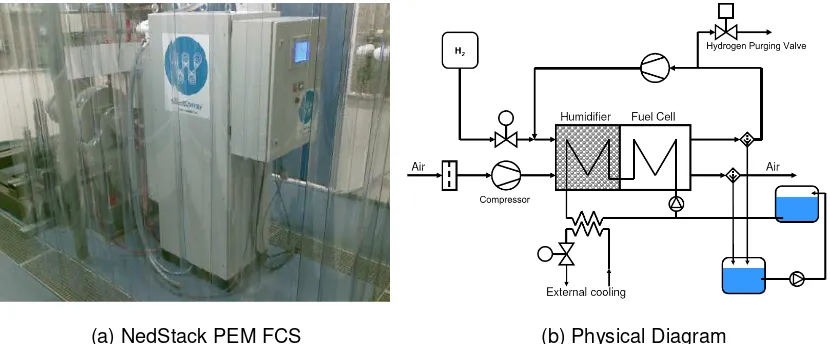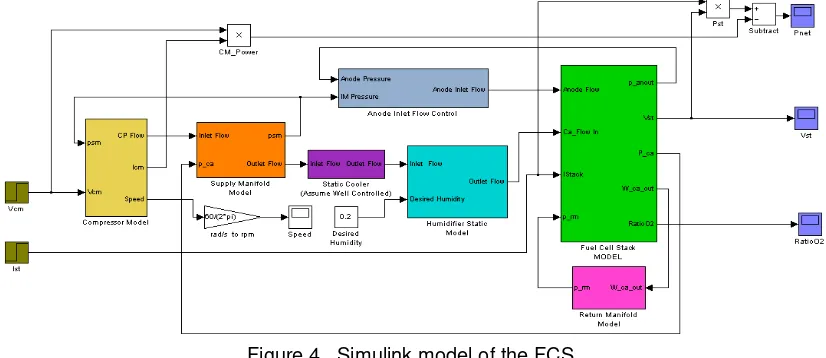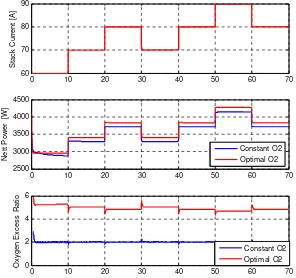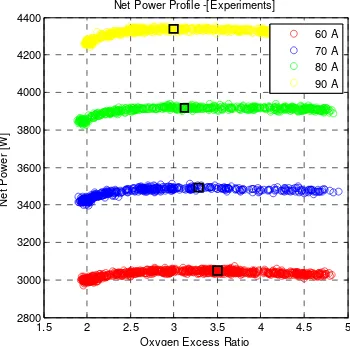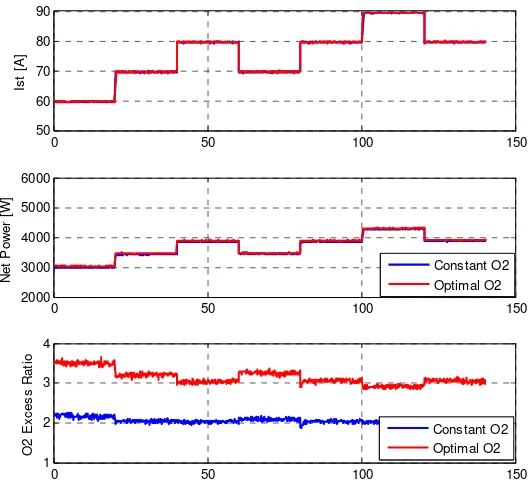ISSN: 1693-6930
accredited by DGHE (DIKTI), Decree No: 51/Dikti/Kep/2010 303
Efficiency of Polymer Electrolyte Membrane
Fuel Cell Stack
Agung Prayitno*1, Olive Kubumwe2, Hans Bosma3, Edwin Tazelaar2
1
Electrical Engineering Dept, University of Surabaya (UBAYA)
Jl. Raya Kalirungkut - Surabaya 60293, East Java – Indonesia, Tel. +62-31-2981157
2
Control System Engineering, HAN University of Applied Sciences, Arnhem, Netherlands Ruitenberglaan 26 6826 CC Arnhem – The Netherlands, Tel. +31-26-3658215
3
Vehicle Mechatronics Dept, HAN University of Applied Sciences, Arnhem, Netherlands Ruitenberglaan 29 6826 CC Arnhem – The Netherlands, Telp. Tel. +31-26-3658293
e-mail: prayitno_agung@ubaya.ac.id*, okubumwe@yahoo.fr, hans.bosma@han.nl, E.Tazelaar@han.nl
Abstrak
Paper ini mengaplikasikan sebuah feedforward control dengan optimal oxygen excess ratio yang memaksimalkan net power (meningkatkan efisiensi) dari NedStack P8.0-64 PEM fuel cell stack (FCS) system. Profil net power yang merupakan fungsi dari oxygen excess ratio untuk beberapa titik kerja dianalisa dengan menggunakan model dari FCS. Hubungan antara arus stack dan tegangan input kompresor pada saat nilai oxygen excess ratio optimal digunakan untuk mendesain sebuah skema kontrol feedforward. Hasil dari skema kontrol ini akan dibandingkan dengan hasil dari skema kontrol yang menggunakan nilai konstan oxygen excess ratio. Hasil simulasi menunjukkan bahwa optimal excess ratio meningkatkan performansi dari fuel cell dibanding penggunaan konstan oxygen excess ratio. Prosedur yang sama juga dilakukan secara eksperimen untuk FCS system. Respon net power dari fuel cell terhadap variasi oxygen excess ratio digunakan untuk mendapatkan nilai optimum dari oxygen excess ratio. Data data dari arus stak dan tegangan input kompressor pada saat nilai optimum tersebut digunakan untuk mendesain feedforward kontrol. Feedforward kontrol dengan konstan dan optimal oxygen ratio kontrol diimplementasikan pada NedStack P8.0-64 PEM FCS system dengan menggunakan Labview. Hasil implementasi menunjukkan bahwa feedforward kontrol dengan optimal oxygen excess ratio meningkatkan performansi fuel cell dibanding penggunaan konstan oxygen excess ratio.
Kata kunci: PEM fuel cell stack, dynamic oxygen excess ratio, static oxygen excess ratio
Abstract
This paper applies a feedforward control of optimal oxygen excess ratio that maximize net power (improve efficiency) of a NedStack P8.0-64 PEM fuel cell stack (FCS) system. Net powers profile as a function of oxygen excess ratio for some points of operation are analyzed by using FCS model. The relationships between stack current and the corresponding control input voltage that gives an optimal oxygen excess ratio are used to design a feedforward control scheme. The results of this scheme are compared to the results of a feedforward control using a constant oxygen excess ratio. Simulation results show that optimal oxygen excess ratio improves fuel cell performance compared to the results of constant oxygen excess ratio. The same procedures are performed experimentally for the FCS system. The behaviour of the net power of the fuel cell stack with respect to the variation of oxygen excess ratio is analyzed to obtain optimal values. Data of stack current and the corresponding voltage input to the compressor that gives optimal values of oxygen excess ratio are used to develop a feedforward control. Feedforward control based on constant and optimal oxygen excess ratio control, are implemented in the NedStack P8.0-64 PEM fuel cell stack system by using LabVIEW. Implementation results shows that optimal oxygen excess ratio control improves the fuel cell performance compared to the constant oxygen excess ratio control.
Keywords: PEM fuel cell stack, optimal oxygen excess ratio, constant oxygen excess ratio
1. Introduction
PEM fuel cells are they have high power density, solid electrolyte, long stack life and low corrotion [4, 5].
A fuel cell consists of two electrodes, anode and cathode, and an electrolyte membrane which is inserted between them. Single fuel cell produces around 0.7 volts. For obtain higher voltage, multiple cells are stacked in series and called fuel cell stack (FCS) system [4]. The PEM fuel cells use pressurized hydrogen and oxygen as a fuel to produce electricity. Hydrogen in anode side will be dissociated into protons and electrons. Protons flow through polymer electrolyte membrane to the cathode and the electrons flow from anode to cathode through external circuit to produce current. In the cathode side, oxygen will react with protons and electrons to produce water and heat [4, 5].
In this research, NedStack P8.0-64 PEM fuel cell stack system at the Applied Research Laboratory Automotive (ARLA) of HAN University of Applied Sciences, Figure 1.a, will be used. The FCS system consists of 68 cells, auxillary systems and control modules. The auxillary systems together with control modules ensure safety working condition. It can be done by regulating anode-cathode pressure ratio, temperature and humidity of the fuel cell, anode purge valve, air compressor voltage to avoid oxygen starvation, safe start up and shutdown sequences. All process outputs and inputs are connected to National Instruments Data Acquisition system (NIDAQ) that gives possibilities to monitor and to implement new control strategies.
(a) NedStack PEM FCS (b) Physical Diagram
Figure 1. NedStack PEM Fuel Cell Stack system
The physical diagram of the FCS system is shown in Figure 1.b. Hydrogen is provided from high pressure hydrogen storage through a control valve. The hydrogen flow is humidified to prevent the membrane (electrolyte) to dehydrate. A surplus of hydrogen is dehydrated and recycled using a compressor. An on/off valve enables purging, to prevent too high concentrations of nitrogen in the hydrogen circuit. This nitrogen diffuses from the air side through the membrane into the hydrogen circuit. The oxygen is provided as air, filtered and pressurized using a compressor. After humidification it enters the fuel cell stack. After dehydration, the remaining air is blown off. The stack is cooled through a cooling circuit with a small pump for circulation and an external heat exchanger, which is cooled by an external cooling circuit. The hydration of both hydrogen and air flow is internally combined with the cooling circuit. The water for humidification is provided by the dehydration of the air and hydrogen flow after the stack [6]
In the existing FCS system, constant oxygen excess ratio ( 2
2 0 =
λ ) is used. A compressor uses a significant a mount of energy generated by the fuel cell stack, resulting in lower system efficiency. A proper dynamic definition of the oxygen excess ratio needed can probably maximize the net power and in the end may improve the efficiency of the FCS. Therefore in this paper, our focus is to investigate possible improvement on the net power by finding the optimal oxygen excess ratio from the net power profile. Based on the suitable control strategies, the algorithm is implemented in the FCS system by using LabView and the experimental result is analyzed.
This paper is organized as follows: Section 2 presents a FCS model and simulation results. Section 3 presents an experiment of steady state analysis. The control implementation and results are presented in section 4 and finally the main conclusions are provided in section 5.
2. FCS Model and Simulation Results
Various attempts for developing models and designing controllers of FCS have been applied. Pukrusphan et al. developed a dynamic fuel cell control-oriented model that is suitable for control studies. The model consists of a fuel cell stack model and auxillary models which consists of a compressor model, a supply manifold model, a static cooler model, a humidifier model, and a return manifold model. Their paper gave a nice presentation of the development of a control-oriented model for understanding the dynamical behaviour of fuel cell systems [1,2,3,4].
The fuel cell model uses nine state variables: one state,
ω
cp, in the compressor model,two states, p ,sm msm, in the supply manifold model, three states, mO2,mN2,mv,ca, in the cathode
model, two states, mH2,mv,an, in the anode model and one state,prm , in the return manifold
model. The air compressor voltage,vcm, is the input of the system and the fuel cell stack
current,Ist, is assumed to be a disturbance input. The outputs of the system are the stack voltage,Vst. A schematic of FCS subsystems and their model state variables are shown in
Figure 2.
Figure 2. Fuel cell system model, indicating model state variables.
They also reported a control strategy for regulating air supply. A static feedforward (sFF) controller is presented to achieve the air flow that replenishes the oxygen flow depleting during current drawn, Ist. In this sFF control schemes, Figure 3, current that acts as a disturbance is measured and a function that shows a relationship between the steady state value of the control input,vcm, and the disturbance, Istis implemented in a look-up table. The
paper assumes that the oxygen excess ratio, 2
O
λ , of the air supply is always constant at 2
2 =
O
λ
[2,4]. Therefore, the net power of the fuel cell stack may not have an optimum value.
Figure 3. Static feedforward controller.
A model based on Puskrusphan’s work will be built to analyse the behaviour of the FCS system, Figure 4. Parameters of the FCS used in this model are obtained from [6]. The air compressor voltage,vcm, and the fuel cell stack current, Ist, are chosen as input variables while variables oxygen excess ratio,
2
O
λ , net power generated by fuel cell stack,Pnet, and the stack voltage,Vst
are chosen as output variables.
Figure 4. Simulink model of the FCS.
According to the objectives of this paper, the important variable in our analysis is the oxygen excess ratio,
2
O
λ , which can be expressed as the ratio between the mass flow rate of oxygen entering the cathode and the mass flow rate of oxygen that has reacted in the process.
rct O
in O O
W W
s ,
,
2 2 =
λ (1)
F
identical, the total stack voltage is a multiplication of number of cells,n
, and the individual cell voltage vfc. The fuel cell voltage can be expressed as the result of the open circuit voltage,E,from which the sum of voltage losses is subtracted: activation overvoltage,
v
act,ohmicovervoltage,vohm, and concentration overvoltage vconc.
conc compressor, which is product of compressor voltage,vcm, and compressor current,Icm [7].
cm power. However, too large values of the oxygen excess ratio,
2 O
λ , will decrease the net power due to extreme power consumed by the compressor.
In this paper, we analyzed the net power output of the FCS when a constant oxygen excess ratio, 2
2 =
O
λ is used and when optimal oxygen excess ratio,
2 O
λ are used. Therefore a steady state analysis of optimal excess ratio is performed both in simulation and in experimental at the operating conditions of the stack temperature. The analysis is performed by defining a certain constant stack current,Ist, then the control input voltage,vcm, is increased in a ramp. This procedure is repeated for several other constant stack currents. An optimal value of
2
O
λ is determined in each point of operation (stack current) and the results are shown in Figure 5.
2 3 4 5 6 7 8 9 10
Oxygen Excess Ratio [Lamda O2]
The relationships between stack current,Ist, and the corresponding control input voltage, vcm, that gives an optimal oxygen excess ratio is approximated using least square estimation. Then, the parameters obtained are implemented in a feedforward control of the FCS model, Figure 3, and the results are shown in Figure 6.
0 10 20 30 40 50 60 70
Simulation showed that application of optimal oxygen excess ratio control improves the net power of the fuel cell stack system at around 3.3%.
3. Experiment of the Steady State Analysis
Labview program is built to investigate the behavior of the FCS system especially the steady state analysis of optimal excess ratio for some points of operation of the stack current. In this experiment, we only investigate the optimal excess ratio for stack currents of 60 A, 70 A, 80 A and 90 A due to a high temperature problem in the compressor when working at high stack currents and high oxygen excess ratios.
To realize this experiment, some process variables such as stack current, stack voltage, pressure cathode input, air mass, compressor current and stack temperature are collected. The vareiables are used to calculate the oxygen excess ratio and the net power of the FCS system. The experiment is performed by drawn a certain stack current, Ist, then the input voltage, vcm,
is increased in a ramp and the resulting netpower and oxygen excess ratio from LabView manipulation are recorded. The procedure is repeated for several other constant stack currents
The measured net powers profile is shown in Figure 7 as a function of the oxygen excess ratio. It can be seen that the optimum value of the oxygen excess ratio,
2
O
λ
, is varying in range between 2.5 and 4. A function that shows the relationship between the stack current and the voltage input to the compressor can be found by using least square estimation.1.5 2 2.5 3 3.5 4 4.5 5 2800
3000 3200 3400 3600 3800 4000 4200 4400
Net Power Profile -[Experiments]
Oxygen Excess Ratio
N
e
t
P
o
w
e
r
[W
]
60 A 70 A 80 A 90 A
Figure 7. Experimental result of net power profile as a function of the oxygen excess ratio
4. Control Implementation and Results
As stated before, the feedforward control scheme for constant and optimal oxygen excess ratio are applied in the NedStack P8.0-64 PEM fuel cell system. The scheme of control application is shown in Figure 8.
Figure 8. Simulink Model of FCS
The fuel cell stack current, Ist, is assumed to be a disturbance input. A feedforward control based on the relationships between stack current,Ist, and the corresponding control input voltage, vcm, that gives an optimal oxygen excess ratio is applied by using LabView. From least square estimation, the relationships of the data stack currents, Ist, and the corresponding control input voltage, vcm, for constant and optimal oxygen excess ratio can be expressed in Equation 5 and 6 respectively.
06
.
0
5
.
3
+
=
stcm
I
v
(5)
03
.
0
99
.
3
+
=
stcm
I
v
(6)
0 50 100 150
Figure 9. Implementation results: constant and optimal oxygen excess ratio
5. Conclusion
A feedforward controller scheme is successfully applied in simulation and implemented in the NedStack P8.0-64 PEM fuel cell stack system to regulate the optimal oxygen excess ratio. Simulation results show that the control of the optimal oxygen excess ratio improves the performance of the fuel cell stack system and enhances its net power output around 3.3%. While in the implementation results the net power output is increase around 0.9%. This controller scheme is easy and practical for implementation.
References
[1] Pukrushpan JT, Peng H, Stefanopoulou AG. Control-Oriented Modeling and Analysis for Automotive
Fuel Cell Systems. ASME Journal of Dynamic Systems. 2004; 126: 14-25.
[2] Pukrushpan JT, Stefanopoulou AG, Peng H. Control of Fuel Cell Breathing. IEEE Control System Magazines. 2004; 24: 30-46.
[3] Pukrushpan JT, Stefanopoulou AG, Peng H. Modeling and Control of PEM Fuel Cell Stack System. Proceedings of the 2002 American Control Conference. Anchorage. 2002; 4:3117 - 3122
[4] Pukrushpan JT, Stefanopoulou AG, Peng H. Control of Fuel Cell Power Systems: Principles, Modeling, Analysis, and Feedback Design. London, Springer-Verlag. 2004.
[5] Ramos-Paja CA, Bordons C, Romero A, Giral R, Salamero LM. Minimum Fuel Consumption Strategy for PEM Fuel Cells. IEEE Transaction on Industrial Electronics. 2009; 56:685-696.
[6] Bosma H, Kemkers E, Tazelaar E. Manual Minor Project Process Industry PEM Fuel cell Hybrid Propulsion System. Arnhem-Netherlands, HAN University of Applied Sciences.2010.
[7] Chang YA, Moura SJ. Air-Flow Control in Fuel Cell Systems: An Extremum Seeking Approach. Proceedings of the 2009 American Control Conference. St. Louis MO. 2009
